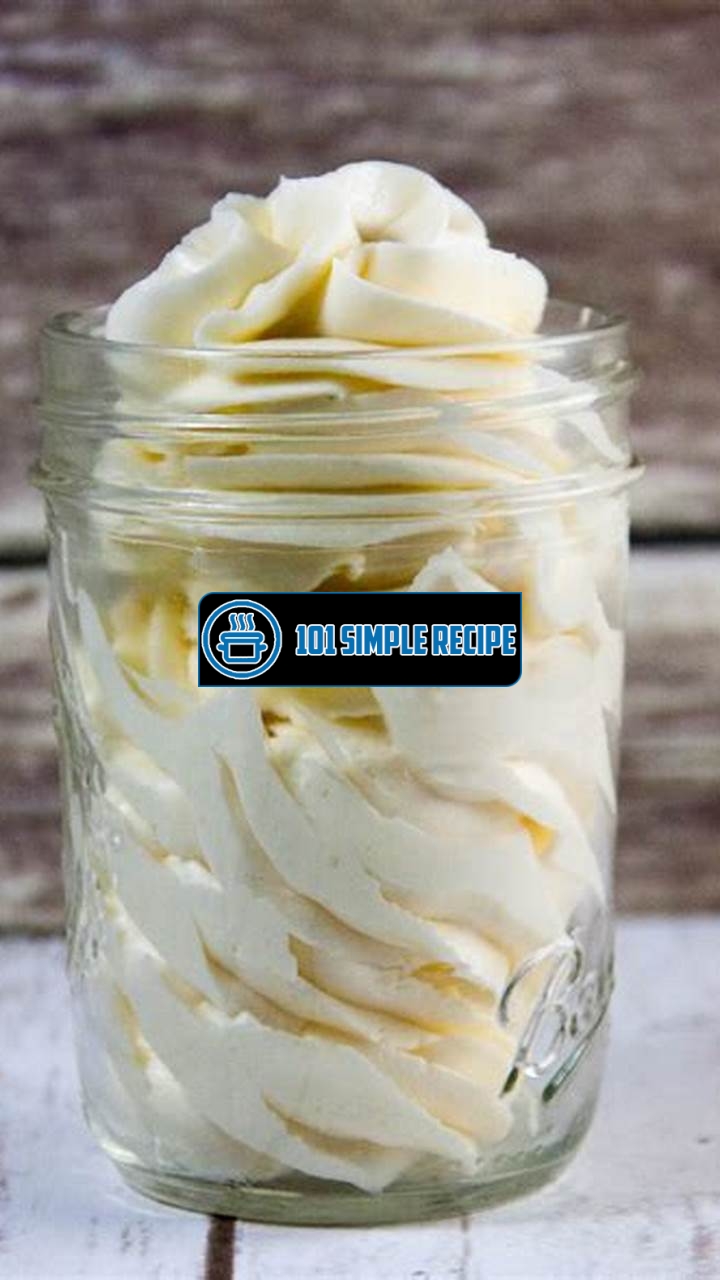If you’ve ever made Swiss Meringue Buttercream, you know that sometimes it can be a bit too soft for your liking. Luckily, there are several techniques you can use to make it stiffer and more manageable. Whether you’re planning to use this delicious frosting for piping elaborate designs on a cake or simply want it to hold its shape better, we’ve got you covered. In this article, we’ll explore the best methods to achieve a firmer Swiss Meringue Buttercream, so you can enjoy a smooth and sturdy frosting for your next baking adventure.

The Science Behind Stiffening Swiss Meringue Buttercream
Creating a perfect and stable Swiss meringue buttercream is an art that requires precise techniques and a deep understanding of the science behind it. By unlocking the secrets to making your buttercream firmer, you can ensure that your cakes and pastries not only look stunning but also maintain their shape and texture. In this article, we will explore the key factors that contribute to stiffening Swiss meringue buttercream, including the role of cream of tartar, incorporating powdered sugar, and the impact of temperature control. With these expert tips, you’ll be able to take your buttercream game to the next level.
The Role of Cream of Tartar
Cream of tartar, also known as tartaric acid, is a crucial ingredient when it comes to making Swiss meringue buttercream stiffer. This white, powdery substance is commonly used in baking and acts as a stabilizer and thickening agent. When added to egg whites during the meringue-making process, cream of tartar helps to strengthen the protein structure of the egg whites, resulting in a more stable foam.
Science tip: Cream of tartar works by lowering the pH of the egg whites, making it easier for proteins to bond together and form a stronger network. This helps the buttercream hold its shape and prevents it from becoming too soft or runny.
Incorporating Powdered Sugar
Another effective way to stiffen Swiss meringue buttercream is by incorporating powdered sugar into the mixture. Powdered sugar, also known as confectioners’ sugar or icing sugar, contains a small amount of cornstarch. This cornstarch acts as a thickening agent and helps to absorb any excess moisture in the buttercream, making it firmer.
Pro tip: To ensure the powdered sugar is fully incorporated into the buttercream, it is important to sift it before adding it to the mixture. This will help prevent lumps and ensure a smooth and creamy consistency.
The Impact of Temperature Control
Temperature plays a crucial role in achieving the perfect stiffness in Swiss meringue buttercream. When working with buttercream, it is essential to make sure that all the ingredients are at the same temperature. This means using room temperature butter and bringing the egg whites to room temperature before whisking them into a meringue.
❄️ Cooling tip: If your buttercream is too soft, you can try chilling it in the refrigerator for a few minutes before rewhipping it. This will help the buttercream set and become firmer.
Warming tip: On the other hand, if your buttercream is too stiff, you can gently warm it up by placing the mixing bowl over a pot of warm water or in a microwave for a few seconds. Be careful not to melt the buttercream completely; you just want to soften it slightly for easier spreading.
By understanding the science behind stiffening Swiss meringue buttercream and implementing these expert tips, you can take your cake decorating skills to the next level. Experiment with different ratios of cream of tartar, powdered sugar, and temperature control to find the perfect consistency for your creations. With practice and patience, you’ll be able to achieve dreamy, stiff buttercream that will impress both your taste buds and your guests.
Choosing the Right Fat to Strengthen Your Buttercream
In order to make your Swiss meringue buttercream stiffer, it is important to choose the right fat. Different types of fats can enhance the structure and stability of your buttercream, giving it the perfect texture and consistency. Let’s explore the different options available:
Exploring Vegetable Shortening
One option you have is to incorporate vegetable shortening into your Swiss meringue buttercream. Vegetable shortening is a solid fat made from vegetable oils, and it can help create a firmer buttercream. It has a higher melting point compared to butter, which means it can withstand warmer temperatures without melting or losing its shape. You can opt for an all-vegetable shortening or a combination of butter and vegetable shortening for best results.
Vegetable shortening is a popular choice for creating buttercream decorations that require precise and intricate detailing, such as flowers or piped designs. It holds its shape well, giving you more control over your creations.
Incorporating Butter Varieties
Another way to make your Swiss meringue buttercream stiffer is by incorporating different varieties of butter. While traditional butter adds rich flavor to your buttercream, it can also make it softer. To achieve a stiffer consistency, you can try using European-style butter or high-fat butter. These varieties have a higher fat content and lower water content, making them ideal for creating a firmer buttercream. Using unsalted butter is recommended, as it allows you to have better control over the saltiness of your final product.
European-style butter is known for its smooth and creamy texture, which can give your buttercream a luxurious feel. It adds a velvety richness to your desserts and is a favorite among professional bakers.
Using Margarine as an Alternative
If you’re looking for an alternative to butter, margarine can be used to make your Swiss meringue buttercream stiffer. Margarine is a plant-based spread that contains vegetable oils and fats. It typically has a higher fat content compared to butter, which can help strengthen your buttercream. However, it is important to choose a margarine that is specifically formulated for baking, as some margarines may contain high water content and additives that can affect the stability of your buttercream.
Margarine is a vegan-friendly option for those avoiding animal products. It can provide a similar texture and stability to butter, allowing you to create delicious buttercream without using dairy.
By choosing the right fat for your Swiss meringue buttercream, you can ensure a stiffer and more stable consistency. Whether you go for vegetable shortening, different varieties of butter, or margarine, each option has its unique benefits and can contribute to the overall success of your buttercream creations. Experiment with different fats to find the perfect balance of flavor and texture for your desserts!
If you want to make Swiss meringue buttercream stiffer, you can try adding more powdered sugar. This can help add structure and thickness to the buttercream. You can find a recipe for Kaiser rolls on our website that uses powdered sugar to create a soft and fluffy texture.
Mastering the Techniques for a Stiffer Swiss Meringue Buttercream
Creating a Swiss meringue buttercream with the perfect consistency can sometimes be a challenge. However, by mastering a few key techniques, you can achieve a stiffer buttercream that holds its shape beautifully. In this article, we will guide you through the step-by-step process to achieve the perfect consistency for your Swiss meringue buttercream.
The Importance of Proper Whisking
Whisking plays a crucial role in creating a stiffer Swiss meringue buttercream. To begin, start by whisking the egg whites and sugar over a double boiler until the sugar has completely dissolved. This is an important step as it helps to stabilize the egg whites and create a smooth texture for the buttercream.
When whisking the mixture, it is essential to maintain a consistent speed and direction. Whisking at a medium-high speed with a rotary or electric whisk will incorporate more air into the mixture, resulting in a lighter and fluffier buttercream. Be sure to continue whisking until stiff peaks form, indicating that the mixture is ready for the next step.
Gradually Incorporating Ingredients
An important technique for achieving a stiffer Swiss meringue buttercream is to gradually incorporate the butter into the whisked egg whites. Begin by cutting the butter into small cubes and adding them one at a time to the mixture. You should add the butter when the mixture has cooled down to room temperature and no longer feels warm to the touch.
As you incorporate the butter, continue whisking at a medium-high speed until all the butter is fully combined and the buttercream becomes thick and smooth. It is crucial to maintain a constant whisking speed throughout this process to ensure proper emulsification and avoid any lumps or separation.
Adding Emulsifiers for Stability
Emulsifiers such as cream of tartar or meringue powder can be added to your Swiss meringue buttercream to enhance its stability and make it stiffer. These ingredients help to strengthen the structure of the buttercream, allowing it to hold its shape better, especially in warmer temperatures.
You can add a small amount of cream of tartar or meringue powder to the egg whites while whisking them. This will provide additional stability and ensure a stiffer consistency for your buttercream. It is essential to note that a little goes a long way, so be cautious not to add too much, as it can affect the taste of the buttercream.
Summary
By mastering the techniques of proper whisking, gradual incorporation of ingredients, and adding emulsifiers for stability, you can achieve a stiffer Swiss meringue buttercream. Remember to whisk the egg whites and sugar until stiff peaks form, gradually add the butter while maintaining a consistent whisking speed, and consider incorporating emulsifiers for enhanced stability. With these steps, you can create a buttercream that holds its shape beautifully and adds a delightful touch to your desserts.
Enhancing Stability with Additives
When it comes to making Swiss meringue buttercream stiffer, there are several additives and ingredients that you can incorporate to achieve maximum stability. These additives not only provide the desired firmness and thickness but also contribute to improved texture. Let’s explore three popular options: gelatin, cornstarch, and xanthan gum.
Utilizing Gelatin for Firmness
If you want to add firmness to your Swiss meringue buttercream, gelatin is a fantastic option. Gelatin is a natural protein derived from animal collagen. It can help stabilize and strengthen the structure of your buttercream, making it less prone to melting or sagging.
To utilize gelatin, start by blooming it in cold water. Once the gelatin sheets or powder have absorbed the water, heat it gently until it dissolves completely. Allow the mixture to cool slightly before adding it to your Swiss meringue buttercream. Incorporate the gelatin gradually, mixing well after each addition, until you reach the desired firmness.
- Tip: Use gelatin sparingly to avoid over-stiffening the buttercream.
Adding Cornstarch for Thickness
Cornstarch is a common kitchen staple that can significantly contribute to the thickness of your Swiss meringue buttercream. It acts as a thickening agent by absorbing liquids and creating a smooth, velvety consistency.
To incorporate cornstarch into your buttercream, mix it with a small amount of liquid (such as milk or water) to create a slurry. Heat the slurry gently over low heat until it thickens, then allow it to cool. Once cooled, gradually add the cornstarch mixture to your Swiss meringue buttercream while whisking continuously. Keep adding until the desired thickness is achieved.
- Tip: Be cautious when using cornstarch, as adding too much can give your buttercream a starchy taste.
Exploring Xanthan Gum for Improved Texture
Xanthan gum is a versatile additive that can not only improve the texture of your Swiss meringue buttercream but also provide additional stability. It is a plant-based thickening agent and stabilizer commonly used in gluten-free baking.
To use xanthan gum, start by whisking it with a small amount of powdered sugar to prevent clumping. Gradually add this mixture to your Swiss meringue buttercream while beating on low speed. Continue mixing until the gum is fully incorporated and the desired texture is achieved.
- Tip: Start with a small amount of xanthan gum, as a little goes a long way in thickening your buttercream.
By incorporating additives like gelatin, cornstarch, or xanthan gum into your Swiss meringue buttercream, you can easily achieve the desired firmness, thickness, and texture. Experiment with these options to find the perfect balance for your creations. Remember to use these additives sparingly and enhance your buttercream without overpowering its delicious flavor.
If you’re looking for a natural way to make Swiss meringue buttercream stiffer, try adding a small amount of cream of tartar. This can help stabilize the buttercream and give it a firmer texture. Our recipe for peanut butter cups includes cream of tartar to create a smooth and creamy filling.
Advanced Techniques for Stiffening Swiss Meringue Buttercream
Take your Swiss meringue buttercream to the next level with these advanced strategies that guarantee a firmer texture.
Blending in Meringue Powder
One effective technique for stiffening Swiss meringue buttercream is blending in meringue powder. Meringue powder, which is made from dried egg whites, adds stability and structure to the buttercream. This ingredient is commonly used in royal icing, but it can also work wonders for stiffening your meringue buttercream.
To incorporate the meringue powder into the buttercream, start by preparing the Swiss meringue base as usual. Once the meringue has reached stiff peaks, gradually add in the meringue powder while continuing to beat the mixture. This will help to fortify the buttercream and give it a firmer consistency.
Note: Adding meringue powder can alter the taste of the buttercream slightly, so be mindful when using it for flavor-sensitive recipes. However, if taste is not a major concern, this technique can be a game-changer in achieving a stiffer buttercream.
Experimenting with Pectin as a Stabilizer
Pectin, a natural thickening agent derived from fruits, can also be used to stabilize your Swiss meringue buttercream and make it firmer. This technique is particularly useful for those who prefer using natural ingredients in their recipes or are looking for a plant-based alternative.
To incorporate pectin into your buttercream, start by preparing the Swiss meringue base. Once the meringue has reached the desired consistency, gradually add pectin while continuing to beat the mixture. Pectin will help to thicken the buttercream, giving it the desired stiffer texture.
Note: When using pectin, it is important to follow the manufacturer’s instructions and choose the appropriate type and amount for your recipe. Different brands and variations of pectin may require specific measurements and techniques.
Using Agar-Agar for Plant-Based Alternatives
If you are following a plant-based diet or looking for an alternative to traditional gelatin, agar-agar can be an excellent option for stiffening Swiss meringue buttercream. Agar-agar is a vegan-friendly gelatin substitute derived from seaweed.
To use agar-agar in your buttercream, dissolve it in water according to the package instructions. Once the agar-agar has fully dissolved, add it to the Swiss meringue base and continue to beat the mixture until it reaches the desired consistency. Agar-agar will provide the stability needed to stiffen the buttercream without compromising its vegan qualities.
Note: It is essential to work quickly when using agar-agar, as it tends to set faster than gelatin. Additionally, agar-agar may have a slightly different texture compared to gelatin, but it will still yield a firm and stable buttercream.
With these advanced techniques, you can elevate your Swiss meringue buttercream and achieve the desired level of stiffness. Whether you choose to blend in meringue powder, experiment with pectin, or opt for agar-agar as a plant-based alternative, the result will be a buttercream with a firmer texture that is perfect for piping and decorating your delicious creations.
Another option to make Swiss meringue buttercream stiffer is to chill it in the refrigerator for a short period of time. This can help firm up the buttercream and make it easier to work with. Check out our cookie in a mug recipe for a delicious treat that can be made quickly and easily.
Frequently Asked Questions
Here are some frequently asked questions about making Swiss meringue buttercream stiffer:
| No. | Questions | Answers |
|---|---|---|
| 1. | How can I make Swiss meringue buttercream stiffer? | To make Swiss meringue buttercream stiffer, you can try adding more powdered sugar. Another option is to chill the buttercream in the refrigerator for a short period of time. You can also beat the buttercream for a longer duration to incorporate more air into it, making it firmer. |
| 2. | Can I use cornstarch to thicken Swiss meringue buttercream? | Yes, you can use cornstarch to thicken Swiss meringue buttercream. Mix a small amount of cornstarch with water to form a slurry, then gradually add it to the buttercream while mixing on low speed. Keep in mind that cornstarch may alter the texture and taste of the buttercream slightly. |
| 3. | Is it possible to salvage runny Swiss meringue buttercream? | Yes, you can try to salvage runny Swiss meringue buttercream. Place the buttercream in the refrigerator for about 15-30 minutes to firm it up. Once chilled, beat the buttercream again until it reaches the desired consistency. If the buttercream remains runny, you may need to add more powdered sugar while beating. |
| 4. | Can I use shortening instead of butter to make Swiss meringue buttercream stiffer? | Yes, you can use shortening instead of butter to make Swiss meringue buttercream stiffer. Shortening has a higher melting point than butter, which can help the buttercream hold its shape better in warm temperatures. However, keep in mind that shortening may affect the taste and texture of the buttercream. |
| 5. | What if my Swiss meringue buttercream becomes too stiff? | If your Swiss meringue buttercream becomes too stiff, you can gradually add a small amount of milk or cream while beating to soften it. Add the liquid in small increments until you achieve the desired consistency. Be careful not to add too much liquid, as it can make the buttercream too thin. |
| 6. | Can I freeze Swiss meringue buttercream to make it stiffer? | Yes, you can freeze Swiss meringue buttercream to make it stiffer. Place the buttercream in an airtight container and freeze it for a short period of time. Thaw it in the refrigerator before using and beat it again to regain the desired consistency. Keep in mind that freezing and thawing may slightly affect the texture of the buttercream. |
Thank You for Reading!
We hope you found these tips on how to make Swiss meringue buttercream stiffer helpful. Experiment with these techniques to achieve the perfect consistency for your cake decorating needs. Remember to have fun and explore different flavors and variations of Swiss meringue buttercream. Check back for more baking tips and recipes on our website. Happy baking!
Jump to Recipe
How to Make Swiss Meringue Buttercream Stiffer

Learn how to make Swiss meringue buttercream stiffer with these helpful tips and techniques. Achieve the perfect consistency for your cake decorating needs.
- 4 large egg whites
- 1 cup granulated sugar
- 1 1/2 cups unsalted butter (softened)
- 1 teaspoon vanilla extract
- In a heatproof bowl, whisk together the egg whites and sugar until combined. Place the bowl over a saucepan of simmering water, making sure the bottom of the bowl does not touch the water. Whisk constantly until the mixture reaches 160°F (71°C) and the sugar is completely dissolved.
- Remove the bowl from the heat and transfer the mixture to the bowl of a stand mixer fitted with the whisk attachment. Beat the mixture on medium-high speed until stiff peaks form and the bottom of the bowl is cool to the touch, about 8-10 minutes.
- Switch to the paddle attachment. With the mixer on low speed, gradually add the softened butter, a few tablespoons at a time, until all the butter is incorporated and the buttercream is smooth and creamy.
- Add the vanilla extract and beat on medium speed until well combined. If the buttercream is too soft, refrigerate for 10-15 minutes before using.
- Use the Swiss meringue buttercream to frost and decorate your cakes or cupcakes.
- Enjoy your beautifully decorated treats with delicious and sturdy Swiss meringue buttercream!






